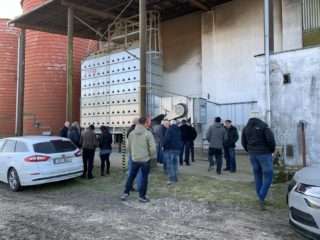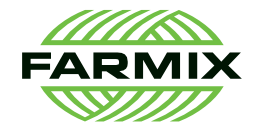Postharvest line technology seminar February 27, 2019
On February 27, 2019, our company, in cooperation with DOTin s.r.o. and SCHAUMANN ČR s.r.o. seminar “New technologies in post – harvest treatment and storage of cereals in the USA and Europe. We thank all participants. Below is a report documenting the seminar.
Post-harvest treatment and storage of cereals in Europe and overseas
Farmix a.s., a post-harvest grain storage and storage specialist, has joined forces with Dotin s.r.o. and Schaumann ČR s.r.o. and jointly organized a seminar entitled “New technologies in post-harvest treatment and storage of cereals in the USA and Europe”. The lectures, which took place on February 27, 2019 in Tábor, were preceded by a tour of the NECO 1690 grain dryer in the agricultural complex in Budislav. The unusual combination of practical excursions and engaging lectures was not missed by the number of participants.
Farmers in Budislav are betting on NECO for the fifth year in a row

An interesting program was launched by the Chairman of the Board of Directors of Farmix, Ing. Miroslav Kastner, who welcomed the participants in the area of ZOD Podhradí – Choustník in Budislav, where they have been using the NECO 1690 grain dryer for several seasons. Satisfaction not only with the dryer itself, but also with other equipment , confirmed to the audience the director of the agricultural cooperative Ing. Jaroslav Kazda.
The dryer was built in 2014, and three years later the MFS slatted floor was installed in four power tanks. As engineer Kazda mentioned, they were looking for a reliable and affordable technology when deciding on a new dryer. The choice ultimately fell on Farmix and their NECO continuous grain dryer. And this decision turned out to be very good. The costs associated with the implementation of the dryer, which works reliably and without complications, were returned to the team in the same year.

The technical parameters of the dryer were presented by Václav Kovář. In general, the main advantage of NECO dryers is the absence of screens. This has a number of advantages – in particular, there is no reduction in capacity due to changes in airflow when the screens are dirty, nor is it necessary to shut down the dryer due to cleaning and replacement of screens. NECO Mixing Air Dryers work on the principle of chamber drying, thanks to which the entire volume of grains is dried evenly and gently. Humidity control of the dried grain is ensured by humidity sensors at the inlet and outlet and there are also temperature sensors inside the dryer. The control panel is equipped with a clear HMI touch screen.
The entire drying process is fully automated, with everything controlled and recorded by the Commander control system. Another great advantage is the special very quiet LAU centrifugal lamella fan. Its noise does not exceed 80 dB, which makes it the position of the heaviest fan on our market. After all, all participants in Budislav were able to see for themselves the quiet operation of the dryer “on their own ears”. The output of the NECO 1960 model reaches 25 tons of wheat per hour while drying the moisture by 4%. In the list of dryers implemented by Farmix, this type is the most common.
Dryer as an essential commodity management tool
After a tour of the dryer area, the participants moved to the Dvořák Hotel in Tábor, where the program continued with lectures in an equally interesting spirit. The first to speak was Ing. Kastner and briefly introduced the company Farmix. It has been operating on the market for more than 20 years and currently offers not only complete and technological units for drying, cleaning and storage of grains and other commodities, but also focuses on design solutions, studies, projects of post-harvest lines and grain storage areas.
In addition to new implementations, they also deal with the modernization of older, already existing post-harvest lines. Of course, commissioning, operator training and all warranty and post-warranty service. Grain dryers are already becoming an almost essential part of agricultural areas, as proper drying is essential to maintain grain quality even during storage. This also gives farmers the advantage of controlling the price of grain and controlling the harvesting process. Dryers thus become a management tool and the farmer becomes the true manager of his commodities.

NECO dryers are, without exaggeration, the market leader in dryers. Václav Kovář revealed more about this extraordinary technique. The main advantage of the mentioned screenless dryers is several heating zones, which ensures great flexibility of the drying process. Not only different drying temperatures but also grain cooling can be set for the individual zones. NECO uses the Commander control system, which is the only drying system in the USA where these devices are created, which has a built-in Dryer Master humidity control system.
This system is standard equipment, which is not always the case with competing dryers. Another great benefit of NECO dryers is their modular system, which works as a kit, so the existing dryer can be increased by additional floors and burners. NECO dryers are manufactured in many models, which differ in height, length of the drying section, number of burners and especially output – customers can choose from output from 15 t/hour. up to 230 t/hour.

This was followed by a performance by a rare guest from the USA, Lee Case, representing Farmix in America. He mentioned in particular the importance of proper drying and moisture content of the grain during storage. When storing barley or oats for a maximum of 6 months, the moisture content of the grain should be kept at 14%, and when stored longer, it should not exceed 13%. For wheat, a moisture content of 13% is required (storage within 6 months), resp. 12% (when stored for more than half a year).
Cooling quality can also be improved by cooling, which can also reduce drying costs by 10 to 15% and at the same time increase the dryer capacity by 10 – 20%. However, cooling also has its rules – above all, it should take place slowly. If the hot grain is cooled sharply, it may crack.
A subsidy for a new dryer can also be obtained from MPO (the Ministry of Industry and Trade).

Ing Marek Pavelec (from DOTin ltd) talked about the possibilities of subsidies for post-harvest technologies from MPO (Ministry of Industry and Trade). Until the end of April this year, the Energy Savings Program (Call IV) is running, in which a total of CZK 6 billion has been allocated. Small, medium and large enterprises, including agricultural or food entrepreneurs, can apply for support.
The supported activities include, among others, reducing energy intensity and increasing the energy efficiency of production and technological processes (applies to post-harvest lines). The evaluation criteria include the readiness of the project (building permit, etc.), its need and relevance, as well as cost-effectiveness (CZK/GJ savings). The evaluation follows from the business plan and energy assessment. One of the important conditions for the profit of the subsidy is the actual use of the newly purchased dryer.
The final presentation belonged to Ing. Jiří Kuníkov, Ph.D. from Schaumann ČR s.r.o. Mr. Doctor introduced grass seeds from the offer of their company, which are suitable for the current changing climate. Forage is the cheapest fodder that a farm can produce on its own. However, it is necessary to pay due attention to grassy areas – the optimal vegetation should consist of at least 80% of quality grasses (fine-leaved reed fescue, perennial ryegrass, meadow fescue, meadow fescue), 10 to 20% should consist of legumes (creeping clover, clover) meadow) and the content of weed species (cream, etc.) should not exceed 10%.
Of the many grass species, the fine-leaved reed fescue is particularly noteworthy, which is very suitable for animal nutrition. It has excellent digestibility, high protein and fiber content and, last but not least, a high yield (12 – 15 t dry matter /ha/year). It has long roots, thanks to which this fescue resists drought well. However, its resistance to winter is also remarkable. Schaumann has had several blends mixed for its customers with the content of fine-leaved reed fescue, which it distributes under the name GREENSTAR.
The series of lectures closed Ing. Kastner, who thanked everyone for their participation and said goodbye by all-encompassing motto “Always Farmix!”
